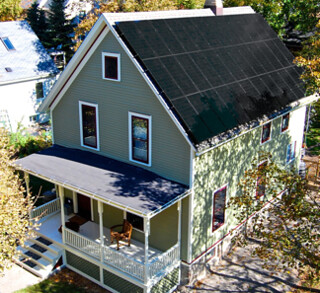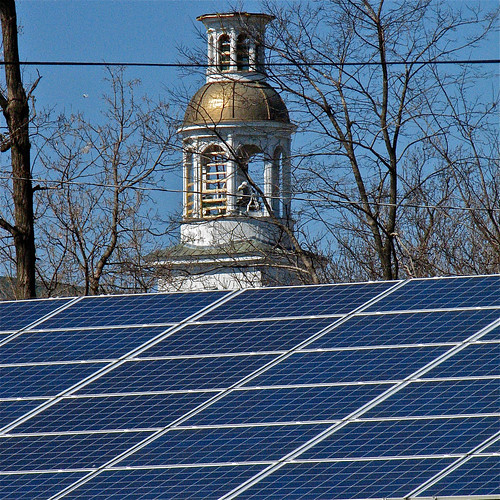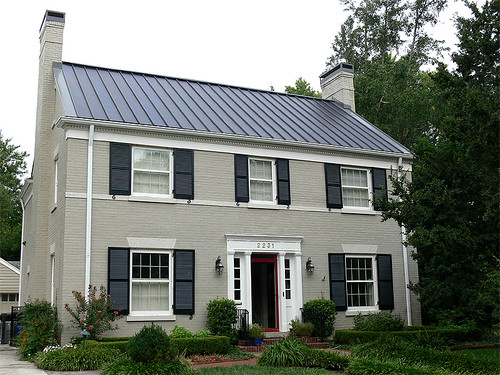When values collide: balancing green technology and historic buildings

Posted June 25, 2012 at 1:29PM
I believe that historic preservation in the right context – a healthy neighborhood – can be intrinsically green. Most historic buildings, at least the ones constructed before the days of freeways and urban flight, are on walkable streets in relatively central locations. They represent embodied energy and materials that would be consumed if the same amount of space and the same function had to be constructed anew. Also, being built before “the thermostat age,” as my friend Steve Mouzon calls it, many of them were built with attention to climate and with locally sourced materials, giving them environmentally beneficial characteristics as a matter of design.
But, by definition, historic buildings do not have the latest technology unless it is added many years later. I agree with Steve that technology can be overrated as an environmental cure-all, but there are clearly some forms of green technology that can strengthen the environmental profile of older buildings. This raises the delicate issue of how much updating can and should occur without compromising the building’s historic character.
A classic conflict – or perceived conflict – of exactly this type has been going on in Washington’s historic Cleveland Park district, where homeowners were denied permission to install visible rooftop solar panels by a local commission. Kathy Orton writes in The Washington Post:
“In a May 31 decision that some saw as limiting solar power in the District, the Historic Preservation Review Board, after initially deadlocking on the issue, voted 4-3 against approving the Chandler-Wingate proposal. Although the board had no objection to the panels that were placed on the rear addition, those who voted against the proposal disapproved of the eight panels on the west side of the house because of their visibility from the street . . .
“The guidelines for solar panels on roofs of historic buildings were adopted by the HPRB in 1997. They state: ‘On a flat roof, solar panels should be located so they are not visible from the public street. If located on a sloping roof building, they should only be installed on rear slopes that are not visible from a public street.’
“’The effect of that is that any house that is south or west facing would not be able to use solar,’ [homeowner Mark] Chandler said. ‘By definition, that’s half the houses’ in DC.’”
Orton writes that the owners had already compromised by proposing panels only on the west side of the roof and not the south side that faces the street. If the panels were placed on the south side, Chandler and Laurie Wingate would be able to reduce their power consumption from the grid by 70 percent. Instead, they proposed 25 panels on the rear and west side, which would still reduce consumption by 42 percent. They subsequently agreed to a suggestion by the city’s Historic Preservation Office that they remove four of the west-facing panels, which reduced the potential savings to 30 percent.
If they can place panels only on the rear, north-facing side (very little direct sunlight in Washington comes from the north), the project will no longer be cost-effective.
Orton continues:
“Some, including [Advisory Neighborhood Commission] Vice Chairman Carl Roller, felt the homeowners had gone a long way toward camouflaging the solar panels. Chandler and his wife wanted to use a more expensive, pure black panel that has no metal frame or rims and extends only five inches from the roof’s surface. They also planned to follow the Interior Department’s guidelines for solar on historical structures by replacing the light-colored asphalt shingles with a darker shingle that would better blend with the panels. ‘I absolutely, unequivocally support historic preservation,’ Roller said. ‘But sometimes I also feel that we get caught up in an overly rigid application of some rules.’”
Last year, I profiled Matt and Kelly Grocoff’s green retrofit of their 110-year-old home in Ann Arbor. One side (not the rear) of their pitched roof is covered with black solar panels and, in my opinion, appears very compatibl e with the home’s architectural character. The Grocoffs believe they have the oldest “net zero” home in America. It is also worth noting that many historic homes have air conditioning units, including window units, visible from the street.
e with the home’s architectural character. The Grocoffs believe they have the oldest “net zero” home in America. It is also worth noting that many historic homes have air conditioning units, including window units, visible from the street.
I have also written that both preservationists and environmentalists should be judicious in asserting our rights and remedies less we lose public confidence in our causes.
Richard Layman, writing in his thoughtful, DC-based blog Rebuilding Place in the Urban Space, comes down in favor of a strict interpretation of historic compatibility standards:
“The reason that historic preservation guidelines work the way they do is to preserve the great economic value present in the historic district as a whole . . . The reality is that in most communities with historic district regulations, the historic districts have significantly higher values than comparable undesignated areas. In fact, historic preservation tends to be the most reliable urban revitalization tool, especially for neighborhoods . . .
“Changes that reduce the architectural integrity and other place qualities and values of individual properties can reduce the value of neighboring properties significantly, such as how living next to an empty, foreclosed house has been found to have a negative effect on property value of abutting houses averaging $150,000 per property.(Research I've seen on the impact of architecturally inappropriate changes shows a property value reduction of around $60,000 for abutting and nearby properties.)
“By repositioning the value and identity of neighborhoods around historic preservation, neighborhoods are stabilized and become more competitive in terms of metropolitan residential landscape. This has been an essential element of the ‘back to the city’ population movement and can't be ignored by cities focused on maintaining the place and economic value of their communities.”
Those are valid concerns, and I would add that the reasons for protecting historic character go well beyond the economic. But Layman goes on to note that he supports a ban on solar panels “on the front, visible portion” of a house, which he believes to be DC’s current policy. The problem is that placement on the front wasn’t an issue in the Chandler-Wingate case. They had already foregone placement in the front in an attempt at a reasonable compromise.
California’s Solar Rights Act prohibits local governments from restrictions on solar energy systems unless they are “reasonable.” A publication by the state’s Office of Historic Preservation says that “reasonable restrictions” under the law “include those that do not significantly increase the cost of the system or significantly decrease its efficiency or specified performance or allow for an alternative system of comparable cost, efficiency and energy conservation benefits.”
The law further defines reasonable restrictions as requirements that do not exceed $2000 in cost or decrease performance by more than 20 percent. The publication illustrates the point by noting that “a recommendation to reposition a photovoltaic panel on a historic roof would be unreasonable if the performance of that panel dropped to below 80 percent of the performance achieved in the originally proposed location,” or if the cost of installing the panel in the recommended location increased by $2000 or more from the originally proposed location.
The preservation commission in Ypsilanti, Michigan will approve solar panels in a historic district only after a property owner has demonstrated that she has taken all necessary measures to increase energy efficiency first, which seems appropriate. There is an excellent summary of relevant regulations and practices pertaining to solar installations in historic districts across the country in guidelines published by the city of Bayfield, Wisconsin. Pertinent to the DC case, the guidance states:
“In situations where the roof is sloped, it would be best to choose a location with the least aesthetic impact. That may mean considering placing the system on the east or west side of the building, rather than on the optimum south-facing location.”
That, of course, is exactly what the homeowners did in DC.
It may seem by the references I have included that I am strongly pro-solar in historic districts. That is not the case. I think it’s a thorny issue that requires compromise and acute sensitivity to design considerations. It may be hard to avoid case-by-case resolutions, since the degree to which a design avoids or mitigates conflicts with historic character, and the degree to which reasonable alternatives are available, are going to be highly contextual. I haven’t seen the Chandler-Wingate house in Cleveland Park, so I can’t truthfully say one way or another. But I do think that relegating solar access to the north side of a house, in the northern hemisphere at least, seems harsh.
The National Trust for Historic Preservation has posted a number of photos showing what it believes are good examples of solar installations that are compatible with historic character (examples here and here). I show some of them along with this post.
In an unsigned article on Inspectors Blog that appears from context to have been written by Matt Grocoff, the author starts with a very basic rhetorical question:
“The first question our Historic District Commissions should be asking is one posed by Henry David Thoreau, ‘what’s the use of a house if you haven’t got a tolerable planet to put it on?’
“I deeply believe that we must preserve old homes and I am a die-hard supporter of historic districts. Preserving and restoring historic properties and neighborhoods helps us know who we are and helps revitalize deteriorating communities. Indeed, it is essential to a sustainable future . . .
“Commissions should certainly collaborate with homeowners to help find the least intrusive way to install panels, while still allowing maximum production efficiency. We don’t want old homes cluttered with poorly designed solar arrays. But, denying applications outright makes historic homes unsustainable in the future energy economy.”
The application wasn’t denied outright in the Cleveland park case. But the ruling had the same effect as if it had been.
Related posts:
- The green dividend from reusing older buildings (January 24, 2012)
- The greenest (historic) building is the one that's in the right context (June 16, 2011)
- They don't build them like they used to: Steve Mouzon's Original Green (June 16, 2010)
- Guest post: preservation (and environmental) advocates must consider the context of our advocacy (May 15, 2009)
- Is the greenest neighborhood the one that is already built? (March 4, 2009)
Move your cursor over the images for credit information.



